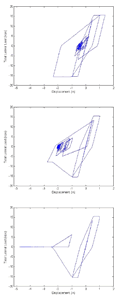| Project Title/ID Number |
RC Frame Validation Tests—5252003 |
| Start/End Dates |
10/1/03—9/30/04 |
| Project Leader |
Jack Moehle (UCB/F) |
| Team Members |
Wassim Ghannoum (UCB/GS), Yoon
Bong Shin (UCB/GS), Tony Yang (UCB/GS) |
F=faculty; GS=graduate student; US=undergraduate student; PD=post-doc; I=industrial
collaborator; O=other
Click on images to enlarge in a new window
1. Project Goals/Objectives:
The goal of this project is to develop validation data and nonlinear models
for nonlinear response, component failure mechanisms, and internal force
redistribution as collapse occurs in a building frame representative of
older concrete construction.
2.
Role of this project in supporting PEER’s mission
(vision):
This project supports the PEER strategic plan by providing performance
data, validation tests, and nonlinear models to advance the simulation
capabilities of OpenSees. Performance data and simulation are central
to the PEER mission of developing performance-based earthquake engineering
methodologies.
3. Methodology Employed:
This project is conducting analyses and experiments on the nonlinear
dynamic response of components and substructures sustaining shear and
axial load failures. These tests provide validation data for simulation
models being developed in OpenSees. Additional work includes development
of mechanical models for shear and axial failure and implementation of
those models in OpenSees.
4. Brief Description of past year’s accomplishments
(Year 6) & more detail on expected Year 7 accomplishments:

Analytical study suggests displacement response strongly depends on in-cycle degradation
We
previously have completed pseudo-static and dynamic shaking table tests
of specimens sustaining shear and axial-load failures. These serve as the
basis for development of analytical models as well as computational procedure.
Models for shear strength have been developed and checked against available
data for representative columns tested both within PEER and by other organizations.
Models for axial-load failure following shear failure also have been developed
and compared with available data. These models show a correlation between
axial load, transverse reinforcement, and drift at failure. We have implemented
the model in OpenSees and have validated it against results of earthquake
simulation tests conducted previously within this project. Additional details
can be found at http://peer.berkeley.edu/%7Eelwood/research/dissertation.htm.
We have found that simulation of axial failure in building frames requires
accurate simulations of displacement response of systems with degrading
strength. Analytical studies suggest that peak displacement is strongly
affected by in-cycle strength degradation, but little data exists to verify
this. We are planning a series of earthquake simulator tests to validate
these models, with tests planned for summer 2004. Another set of tests for
later in the year extends the study to multi-story systems.
5. Other Similar Work Being Conducted Within and Outside
PEER and How This Project Differs:
Researchers in Japan and Taiwan have carried out similar work. The details
and configurations used in those tests are different from those considered
common and most critical for existing US buildings. However, we remain
in close contact with our counterparts in other countries so that we can
take advantage of their conceptual thinking, data, and analysis models.
Within PEER, we are collaborating with developers in OpenSees to ensure
optimal development of analytical models and simulation modules. A companion
project in PEER (PI Mosalam) will collaborate in developing analytical
models.
6. Plans for Year 8 if project is expected to be continued:
We anticipate completing earthquake simulator tests during Years 7 and
into Year 8. We propose to continue work in this general direction with
emphasis on the development of nonlinear models/simulation strategies for
systems with strength degradation.
7. Describe any actual instances where you are aware your
results have been used in industry:
8. Expected Milestones & Deliverables:
-
Complete shaking table tests on single-story specimens (December
2004).
-
Complete shaking table tests on multi-story specimens (June 2005).
